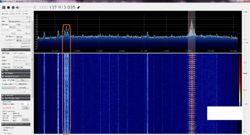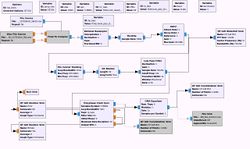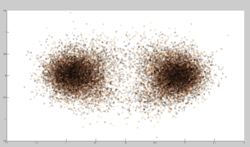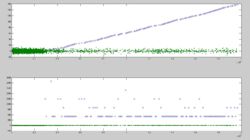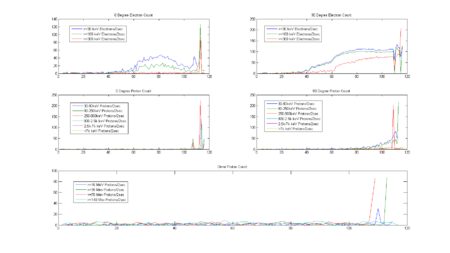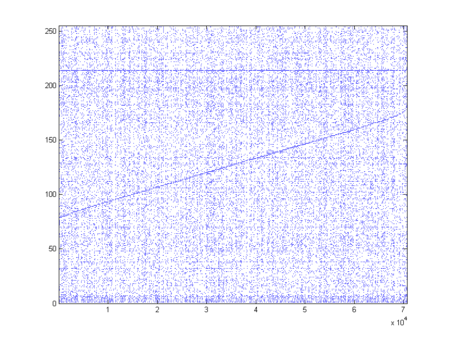Difference between revisions of "NOAA POES TIP Demodulation"
(added DCS-2 message data) |
|||
| Line 82: | Line 82: | ||
====Analysis of data==== | ====Analysis of data==== | ||
| − | Byte 1 Always 214 | + | Byte 1 Always 214<br /> |
| − | Byte 2 A number 0-7, perhaps the sat receiver channel? | + | Byte 2 A number 0-7, perhaps the sat receiver channel?<br /> |
| − | Byte 3 Repeating common values | + | Byte 3 Repeating common values<br /> |
| − | Byte 4 Contains 0-7 channels in the upper 3 bytes and a constant in the lower 5 bits (update: "00110" (NOAA15) but in NOAA18 has "10101") | + | Byte 4 Contains 0-7 channels in the upper 3 bytes and a constant in the lower 5 bits (update: "00110" (NOAA15) but in NOAA18 has "10101")<br /> |
| − | Byte 5 A counting up signal, clock perhaps? | + | Byte 5 A counting up signal, clock perhaps?<br /> |
| − | Byte 6 random data | + | Byte 6 random data<br /> |
| − | Byte 7 contains embedded trends | + | Byte 7 contains embedded trends<br /> |
| − | Byte 8 contains random data | + | Byte 8 contains random data<br /> |
| − | Byte 9 Contains 0-16 in the upper nibble with 0's in the lower nibble -- I think this is the end of the header and start of actual data from the ground (I could be wrong) | + | Byte 9 Contains 0-16 in the upper nibble with 0's in the lower nibble -- I think this is the end of the header and start of actual data from the ground (I could be wrong)<br /> |
| − | Byte 10 contains almost evenly spaced values | + | Byte 10 contains almost evenly spaced values<br /> |
| − | Byte 11 contains multiple data sets with most between 0-64 | + | Byte 11 contains multiple data sets with most between 0-64<br /> |
| − | Byte 12+ we see some messages ending here, and some that keep going but generally random values from here on | + | Byte 12+ we see some messages ending here, and some that keep going but generally random values from here on<br /> |
==Todo== | ==Todo== | ||
Revision as of 09:32, 4 September 2015
Problem Statement
While listening to NOAA APT signals I noticed a strange telemetry signal at 137.35 and 137.77 that tracked NOAA POES sats. At first I thought it was a second sat, but then I realized that the doppler shifts matched too closely. I found the handbook for the satellite constellation, which makes mention of a DBD or TIM signal
Research
I can't actually find any instance of anyone using SDR to decode this signal. I decided that this needed to change :)
I found these documents which describe the modulation and format [1] [2]
Modulation Format
I discovered that this is a very old modulation scheme, dating back to at least the late 60's. The scheme is a BPSK that uses a modulation index of 67 degrees to preserves the carrier for tracking purposes. It is also Manchester encoded, which means that even though the stream is 8320 bps, it is encoded using double the number of symbols, or 16,640 sps.
GNU Radio Script
I wrote a GNU radio workflow to prepare the data for demodulation. http://nebarnix.com/sdr/nocarrier_lowpass_polyphase_equalizer.grc
File Source->Throttle->AGC2->Carrier Tracking PLL->High Pass Filter (to remove carrier)->Polyphase Clock Sync w/ lowpass proto->CMA Equalizer->File Sink (post GNU radio file and block image here)
Matlab Script
I decided to process the data in Matlab because I wanted access to all of the analytical tools until I could figure out what I was doing. Update: added some updates to the Manchester decoder. Here's a link to the crappy matlab script I have written to do most of the data processing and extraction.
http://wiki.nebarnix.com/w/images/6/69/Decode_syncd_IQ2.m
Here's the final constellation of bits. It is still crappy.
The circles are the locations where the sync word, "11101101 1110001 0000" appear. The bottom plot is a diff of the first, showing intervals of 832bits (minor frame length) which proves this is good data. The green dots are where there are Manchester encoding errors (two 1's or two 0's in a row not on a bit boundary). Note that there is no error correct -- unless I find a better way to clean up the phase constellation (or get a better signal) -- or weed out 'barely' bad bits, I probably don't have more than a couple perfect minor frames... it takes 32 seconds or 3200 minor frames to make up a whole major frame. I have some work left to do smile emoticon
Raw IQ Recordings
- http://nebarnix.com/sdr/POES_56k250.raw 56.250khz IEEE 32-bit float raw IQ recording of the (I think) NOAA-18 beacon at 137.35Mhz
- http://nebarnix.com/sdr/pll_nocarrier_polyphased_equalized_loproto.raw IEEE 32-bit float raw IQ output from the GNU radio script at 1 symbol per sample to pull into matlab.
Data Extraction
I have updated the matlab script to extract a few of the instruments embedded in the stream!
SEM-2
The SEM-2 (Space Environment Monitor) contains two experiments, the MEPED (Medium Energy Proton and Electron Detector) and the TED (Total Energy Detector) The following MEPED and TED data was taken as the NOAA15 spacecraft flew north from Hungary to Scandinavia and into the auroral oval.
DCS-2
The DCS/2 experiment is a re transmission from mobile platforms (sea buoys, arctic fox collars, sea ice monitors, weather balloons etc etc). The format is not provided, as the instrument is owned and managed by CNES of France. I plotted the raw stream to tease out patterns in the data. What juicy mysteries lay here :)
Interestingly enough, the DCS/2 experiment locks onto the mobile transmitter and records the frequency deviation. Using this data and knowing the orbit of the satellite, it is possible to calculate the location of the mobile platform by using its Doppler shift... Even if we can only take guesses at what it may be, it should be possible to plot these locations on a map if we can just find the right data...
Looking at this plot, it is easy to see that there are two very clear trends. There is the value 214 (0xD6 or 11010110) that appears over and over again and there is also what looks like a linearly increasing value, perhaps a counter or clock. Looking at the data, a lot of instances of 0xD6 are preceeding by lots and lots of zeros. This must be the message start sync word! Searching for "00 00 D6" (which probably excludes packets that are closely spaced, but captures most of them) and grabbing the following 64 bytes (surely enough bytes to see any patterns in the data) yields a long dist of messages, some of which are longer than 64 bytes and some that are very small. All are at least 9 bytes long, and have several fixed values (which may be dynamic between spacecraft or data-sets, remember, this is only one NOAA-15 pass we are looking at)
An example of the messages follows (the entire list can be found here http://nebarnix.com/sdr/DCS_64B.txt):
D6 01 CB A6 77 74 CF 18 30 00 3A 62 D0 82 E2 F4 C4 3A 15 C1 57 47 04 AE 45 44 41 70 23 8E 08 E3 B1 C8 E4 71 40 9C 31 94 00 00 00 00 00 00 00 00 00 00 00 00 00 00 00 00 00 00 D6 04 FA 46 77 7E 68 D6 04 FA 46 77 7E 68 88 B0 E1 00 00 00 00 00 00 00 00 00 00 00 00 00 00 00 00 00 00 00 00 00 00 00 00 00 00 00 00 00 00 00 92 9D 8B 00 00 00 00 00 00 00 00 00 00 D6 01 22 46 77 CA 8F 9E A0 8B 40 D6 01 22 46 77 CA 8F 9E A0 8B 40 00 00 C4 E8 2F 00 00 00 00 00 00 00 00 00 00 00 00 00 00 00 00 00 00 00 00 00 00 00 00 00 00 00 00 00 00 00 00 00 00 00 00 00 00 00 00 00 00 00 00 00 00 00 00 00 D6 01 0A 26 78 14 D5 92 00 BE B7 C8 B9 B5 E8 29 00 00 00 00 00 00 D6 06 C3 06 77 EB B7 D9 80 AD 35 4D BE CD BE F5 A2 C3 B9 CB BB 7C 53 C1 21 6D D8 F7 D1 55 F5 AD 3F B0 59 C7 79 84 A6 84 D6 00 A3 D6 06 C3 06 77 EB B7 D9 80 AD 35 4D BE CD BE F5 A2 C3 B9 CB BB 7C 53 C1 21 6D D8 F7 D1 55 F5 AD 3F B0 59 C7 79 84 A6 84 D6 00 A3 A6 77 F5 66 3D E0 4C 10 11 F1 CB 78 63 D6 63 D4 DD 39 FC 6E AC D6 D6 02 09 86 78 63 C0 AF D0 02 97 29 BC 96 2A BF 00 00 00 00 00 00 00 00 00 00 00 00 00 00 00 00 00 00 00 00 00 00 00 00 00 00 00 00 00 00 00 00 00 00 00 00 00 00 00 00 00 00 00 00 00 00 00 00 D6 D6 06 F3 66 78 48 6D 9E 60 35 E3 00 00 00 00 00 00 03 00 1B 34 00 00 00 00 00 00 32 01 B3 80 00 00 00 00 00 03 20 1B A0 91 A0 0E 6B 00 00 00 00 00 00 00 00 00 00 00 00 00 00 00 00 00 00 00 00 00 D6 01 6A A6 78 84 69 44 60 6A 84 12 41 AC B5 DE B2 7D A7 B5 F1 E4 85 CB 5D 81 13 83 D6 00 C4 A6 78 6C CE F7 00 F2 34 A1 4A FA E1 18 90 32 15 72 5C 85 C8 B9 04 57 45 70 00 00 00 00 00 00 00 01 20 D6 06 C4 26 78 B8 B7 0F 60 79 36 E1 F6 E5 48 BE D9 76 6E F7 19 7B FB 48 39 45 6B 44 FB D7 14 FF 6D 66 B1 E4 FF 47 03 AA D6 00 C5 C6 78 86 22 A3 50 35 3D 46 C4 2B 02 A8 66 5C C4 DC 38 66 71 5E EC D6 01 FB 06 78 CF D8 62 70 AD DF 14 2E 02 88 03 92 57 71 93 81 7B 2B A7 AF 73 3B F3 8B B5 FB BB BF BB BE FF FB FF FF FF FC C1 FD 0F D6 03 C1 86 78 E2 B6 B3 50 D4 3C 03 47 BF 96 EC 20 D0 A5 A5 C9 D6 02 CA 46 78 FA B7 47 F0 F2 3F 6E C1 3C EC 17 34 06 02 F7 74 39 DC 85 97 B8 66 29 E7 FF 7F 80 77 F0 1E 69 82 63 88 81 D6 04 CD 86 79 01 90 63 50 F2 3A 00 D3 81 17 2E B4 52 BF 3A 23 99 CC B1 B5
Analysis of data
Byte 1 Always 214
Byte 2 A number 0-7, perhaps the sat receiver channel?
Byte 3 Repeating common values
Byte 4 Contains 0-7 channels in the upper 3 bytes and a constant in the lower 5 bits (update: "00110" (NOAA15) but in NOAA18 has "10101")
Byte 5 A counting up signal, clock perhaps?
Byte 6 random data
Byte 7 contains embedded trends
Byte 8 contains random data
Byte 9 Contains 0-16 in the upper nibble with 0's in the lower nibble -- I think this is the end of the header and start of actual data from the ground (I could be wrong)
Byte 10 contains almost evenly spaced values
Byte 11 contains multiple data sets with most between 0-64
Byte 12+ we see some messages ending here, and some that keep going but generally random values from here on
Todo
- Get better data. The signal is weak, only about 1 watt, which means that getting 32 seconds (major frame) of GOOD clean data is somewhat difficult. Alternatively I could make the demodulator more robust, though I'm not quite sure how to do that just yet. *Update*: Reddit user _COD32_ was able to capture several minutes of very high quality data to play with! This has already helped a lot.
- Write a routine to pull the bytes apart using the sync word and then shuffle them into ident bins. This shouldn't be hard, just tedious. *Update*: I have pulled the minor frames apart and plotted minor frame counter data. Look at that counter go!
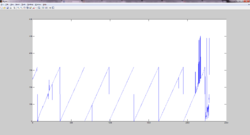
- Make the GNU radio script more tolerant of noise. Airplanes flying overhead transmit ACARS packets that blast the sat signal out of the water from time to time. The clock sync seems to lose lock easily and doesn't like to re-aquire it after a few hard knocks.
